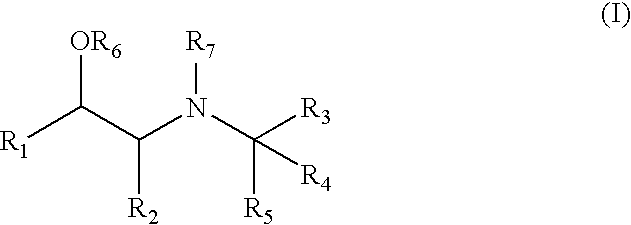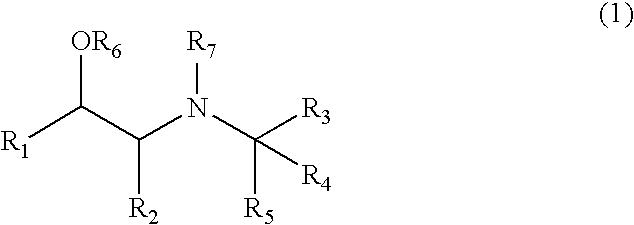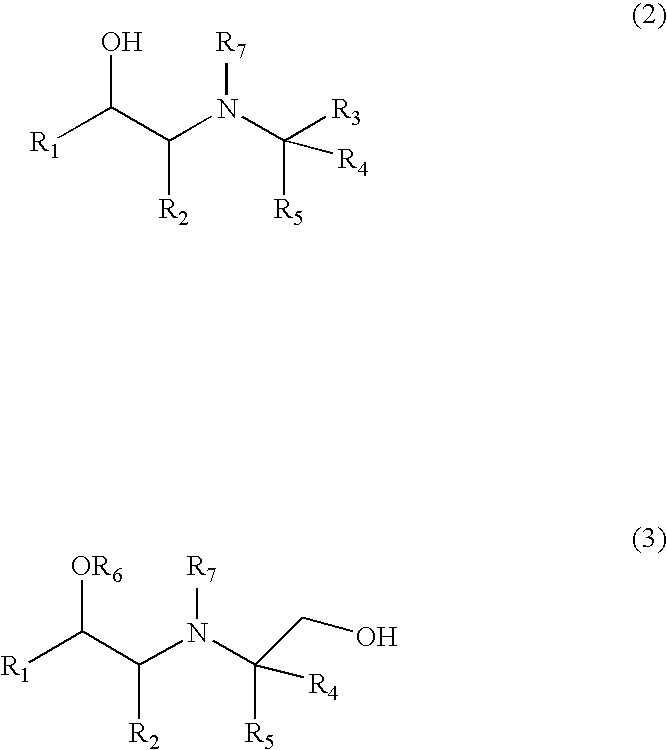Aminoalcohol Derivatives and Their Therapeutic Use
- Summary
- Abstract
- Description
- Claims
- Application Information
AI Technical Summary
Benefits of technology
Problems solved by technology
Method used
Image
Examples
example 1
(+)-(erythro)-Acetic acid 2-tert-butylamino-1-(3-chloro-phenyl)-propyl ester
[0049]
[0050]To a solution of (+)-(erythro)-2-tert-butylamino-1-(3-chloro-phenyl)-propanol (2.0 g, 8.27 mmol) in dichloromethane (50 mL) at room temperature and under N2 was added N,N-dimethylaminopyridine (1.01 g, 8.27 mmol), triethylamine (5.8 mL, 41.35 mmol), and acetyl chloride (0.57 mL, 9.92 mmol). The resulting orange solution was stirred for 16 h. The reaction was monitored by TLC DCM:MeOH:NEt3 (98:2:0.1), followed by quenching with aq. Na2CO3 (50 mL). The mixture was extracted into dichloromethane (3×50 mL) and the combined organic phases were dried (MgSO4), filtered, and concentrated under reduced pressure to leave an orange oil (1.82 g, 77%). 1H NMR (400 MHz, CDCl3) 0.98 (9H, s), 0.99 (3H, bs), 2.12 (3H, s), 3.01-3.02 (1H, m), 5.51-5.53 (1H, m), 7.23-7.31 (4H, m). 13C NMR (100 MHz, CDCl3) 19.6, 21.3, 30.0, 50.9, 51.4, 77.4, 125.4, 127.3, 127.8, 129.3, 134.1, 140.0, 170.4.
example 2
(+)-(erythro)-Isobutyric acid 2-tert-butylamino-1-(3-chloro-phenyl)-propyl ester
[0051]
[0052]To a solution of (+)-(erythro)-2-tert-butylamino-1-(3-chloro-phenyl)-propanol (2.0 g, 8.27 mmol) in dichloromethane (50 mL) at room temperature and under N2 was added N,N-dimethylaminopyridine (1.01 g, 8.27 mmol), triethylamine (5.8 mL, 41.35 mmol), and isobutyryl chloride (1.04 mL, 9.92 mmol). The resulting orange solution was stirred for 16 h. The reaction was monitored by TLC DCM:MeOH:NEt3 (98:2:0.1), followed by quenching with aq. Na2CO3 (50 mL). The mixture was extracted into dichloromethane (3×50 mL) and the combined organic phases were dried (MgSO4), filtered, and concentrated under reduced pressure to leave an orange oil (2.15 g, 83%). 1H NMR (400 MHz, CDCl3) 0.97 (9H, s), 1.05 (3H, d), 1.21 (6H, t), 2.62-2.64 (1H, m), 3.02-3.03 (1H, m), 5.51 (1H, d), 7.22-7.30 (4H, m). 13C NMR (100 MHz, CDCl3) 19.1, 19.6, 30.0, 34.3, 50.9, 51.6, 79.2, 125.2, 127.1, 127.7, 129.3, 134.1, 141.6, 176.5.
example 3
(+)-(erythro)-3-Methoxy-propionic acid 2-tert-butylamino-1-(3-chloro-phenyl)-propyl ester
[0053]
[0054]3-Methoxypropionic acid (2.0 g, 19.21 mmol) was dissolved in anhydrous dichloromethane (30 mL) and oxalyl chloride (3.35 mL, 38.42 mmol) was cautiously added. The mixture was stirred at room temperature for 16 h. The solvent was removed under reduced pressure to leave 3-methoxypropionyl chloride as a brown oil. This material was used without any further purification (2.2 g, 94%). 1H NMR (400 MHz, CDCl3) 3.08 (2H, t), 3.33 (3H, s), 3.65 (2H, t).
[0055]To a solution of (+)-(erythro)-2-tert-butylamino-1-(3-chloro-phenyl)-propanol (2.0 g, 8.27 mmol) in dichloromethane (50 mL) at room temperature and under N2 was added N,N-dimethylaminopyridine (1.01 g, 8.27 mmol), triethylamine (5.8 ml), 41.35 mmol), and 3-methoxypropionyl chloride (1.22 g, 9.92 mmol). The resulting orange solution was stirred for 16 h. The reaction was monitored by TLC DCM:MeOH:NEt3 (98:2:0.1), followed by quenching with...
PUM
| Property | Measurement | Unit |
|---|---|---|
| Composition | aaaaa | aaaaa |
| Therapeutic | aaaaa | aaaaa |
Abstract
Description
Claims
Application Information
 Login to View More
Login to View More - R&D
- Intellectual Property
- Life Sciences
- Materials
- Tech Scout
- Unparalleled Data Quality
- Higher Quality Content
- 60% Fewer Hallucinations
Browse by: Latest US Patents, China's latest patents, Technical Efficacy Thesaurus, Application Domain, Technology Topic, Popular Technical Reports.
© 2025 PatSnap. All rights reserved.Legal|Privacy policy|Modern Slavery Act Transparency Statement|Sitemap|About US| Contact US: help@patsnap.com



